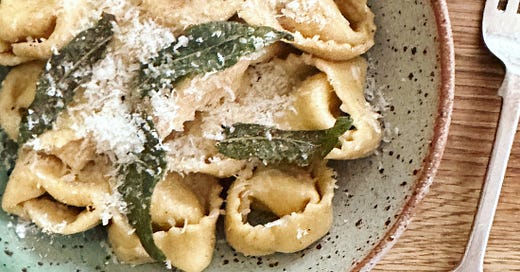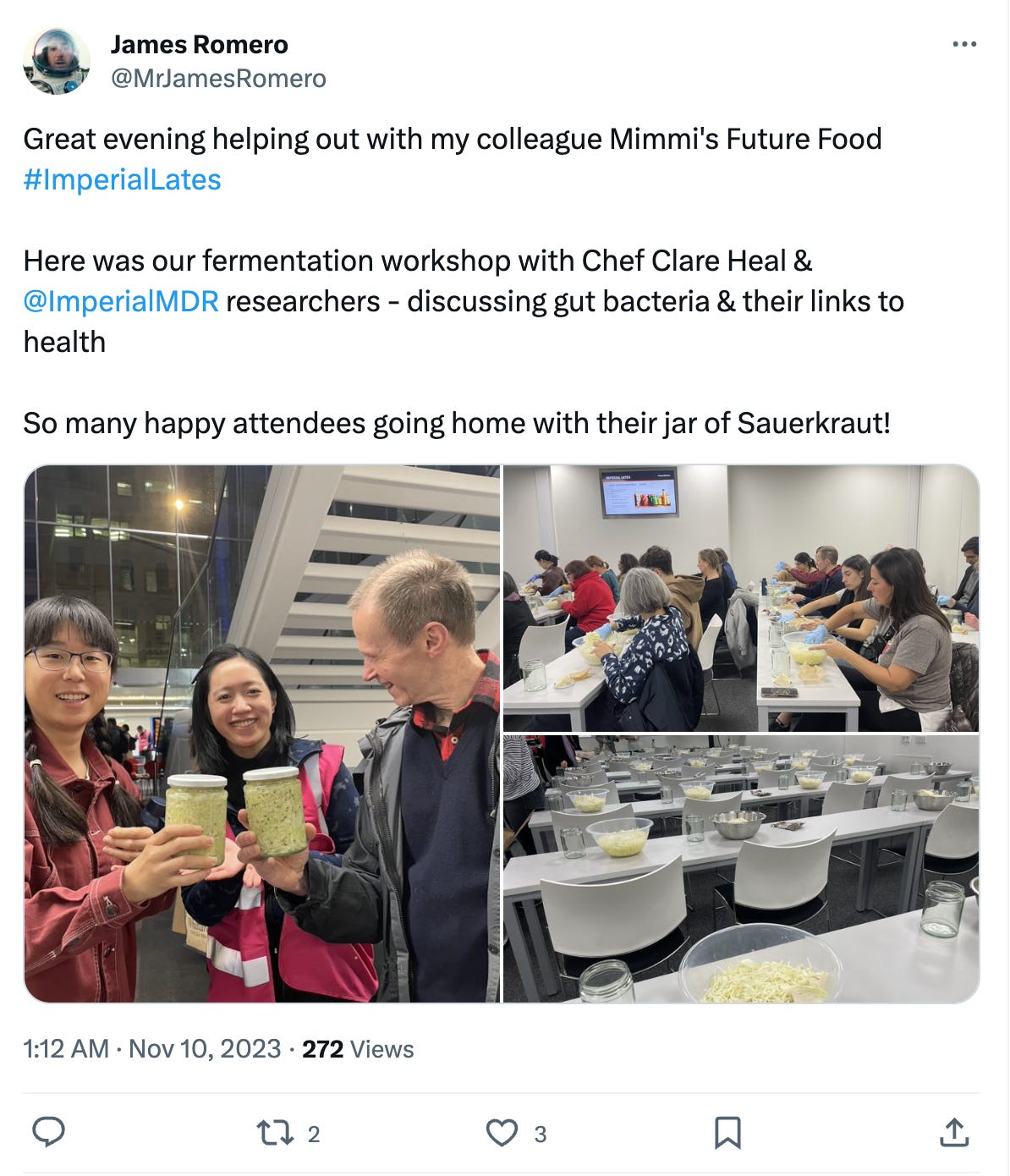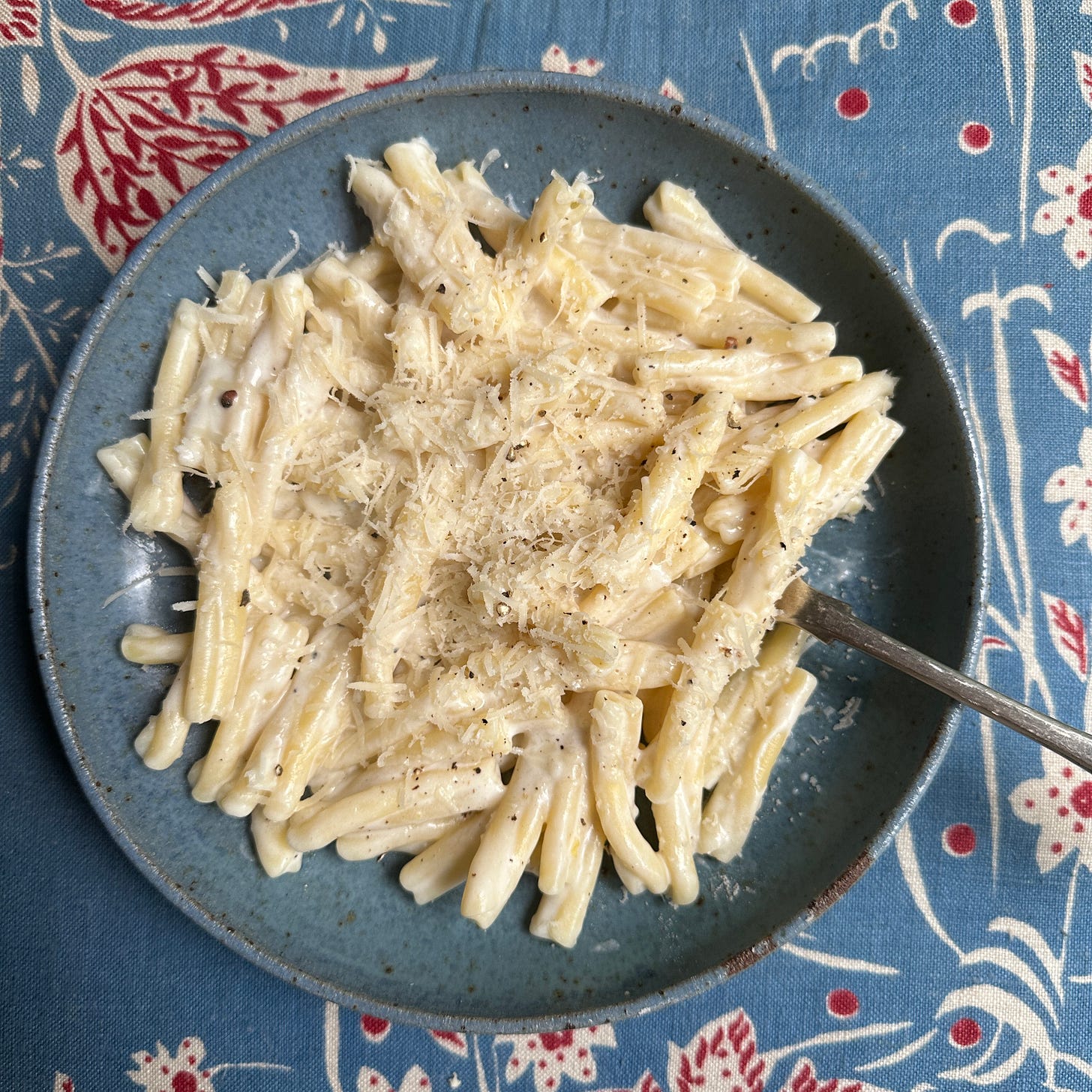In Good Taste #22: Preserved Lemon & Ricotta Pasta Two Ways
Fancy and speedy versions of a comforting autumnal dish; 4,000 hours is all we get (if we're lucky); an unusual advent calendar recommendation
Well, hello there! How are you?
Good I hope. Thank you so much for being here.
(Not up for the chitchat? Completely get it. Click the email title to go to a web-based version then jump straight to the recipes or Cultural Fun.)
I don’t kid myself that any of you are refreshing your email inboxes on a Thursday, grinding your teeth with impatience and lamenting: “When, oh when, will Clare be sending me this week’s ferment or ferment-adjacent recipe?”. But, nevertheless, many apologies for the delay in sending this week’s newsletter.
It’s been one of those everything at-once-weeks, but in a good way. I had a particularly great time at Imperial College last night at their Future Food event, part of the Imperial Lates series. Dr. Maria Valdivia Garcia of the Faculty of Medicine, Department of Metabolism, Digestion and Reproduction and I presented three workshops throughout the evening, each packed to their capacity of 40 people. I taught people how to make sauerkraut and she spoke about her research into the gut microbiome.
Less fun was the morning spent shredding enough cabbage for 120 people… These four bags containing about 20 cabbages between them but were less than a third of the brassica mountain!
We had a really great team of volunteers helping out and the whole occasion was really well run with an impressively diverse mixture of attendees. I’m only sorry I didn’t have the chance to see any of the other presentations. The next event is space-themed and is on December 7th. A great (and free!) evening out.
Cooking with preserved lemons
Last week I suggested you gave you some salad dressing/dip recipes, easy ways to start incorporating the complex, acid-umami flavours of your preserved lemons. This week we’re getting a little more involved with a couple of pasta dishes.
(If you made your own lemons, check out this section from last week about how to tell if they’re ready and instructions for turning them into a versatile paste to keep in the fridge. If you didn’t, both recipes today will work beautifully with shopbought - see the notes for how to use them.)
Both utilise more or less the same flavours - our lovely lemons tempered by the blank-canvas creaminess of ricotta. But we’re going to go about it in two different ways. One approach that’s suitable for an on-the-table-in-15-minutes weeknight supper and another that’s a bit of a project if you fancy liberating the pasta machine from the back of the cupbaord.
Did you know that fresh pasta is my other great culinary love? It’s almost always on my supper club menus in some form or another and I also teach classes, both at the Dusty Knuckle and privately. Expect more pasta in future issues…
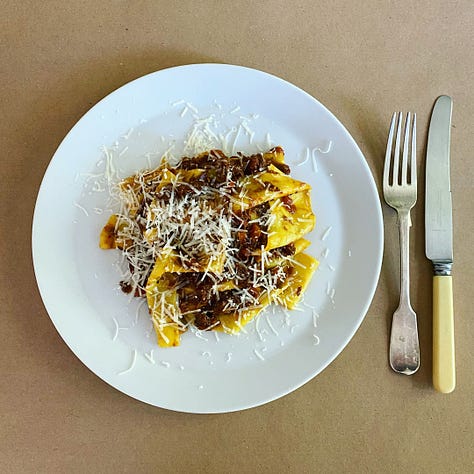

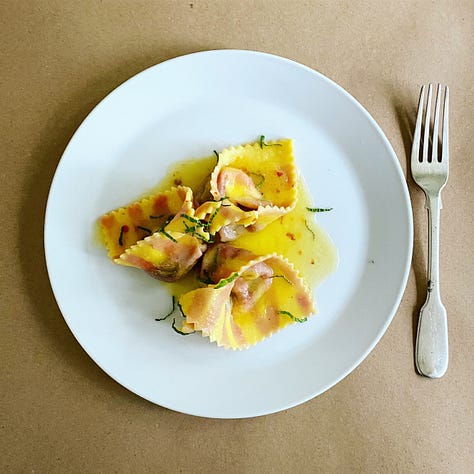
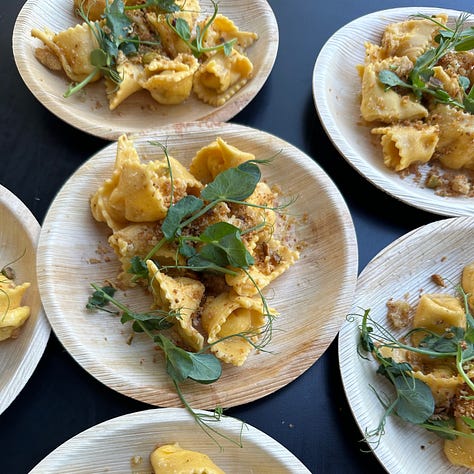
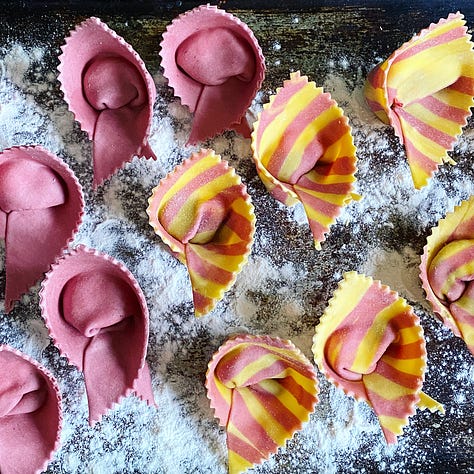
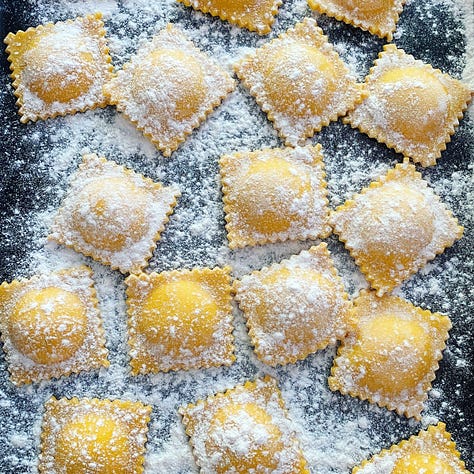
Recipe: Preserved Lemon & Ricotta Tortelloni with Browned Sage Butter
Serves 4
Ingredients
For the pasta
300g ‘00’ flour
2 eggs
4 egg yolks
For the filling
1 onion
250g ricotta
2 tbsp preserved lemon paste
1/4 tsp ground nutmeg
40g Parmesan (or veggie hard cheese), finely grated, plus extra to serve
black pepper
For the butter
100g butter
small bunch sage, leaves only
wedge of lemon
Method
To make the pasta, weigh the flour into a bowl and add the eggs and extra yolks. Use a fork or dough scraper to beat or chop in the eggs then bring the dough together into a ball with your hands.
Knead on the worktop for about five minutes until the dough has a really smooth texture and springs back slightly when you poke it with a finger. It should be ever-so-slightly tacky to the touch but not damp or sticky. If it is, knead in a bit more flour. If it feels dry and craggy, dampen your hand with water (or use little of the spare egg white) and knead that in. Either way, make any addition gradually and knead for another minute before adding more flour/moisture or you risk going too far in the other direction.
Wrap the pasta dough in clingfilm and set aside for half an hour.
Meanwhile, slice the onion and put it in a small pan over a low-medium heat with a good splash of olive oil and a pinch of salt. Sweat until soft, sweet and translucent and just beginning to brown then transfer to a bowl and allow to cool slightly.
Add the ricotta, preserved lemon paste, nutmeg and Parmesan and mix well. Taste and season with salt and black pepper. It probably won’t need much salt becasue of the Parmesan. Set the filling aside.
Roll the pasta to the thinnest setting on your machine. Try to get the sheet to take up the full width of the rollers. Flour your work surface, lay out the pasta (you might not get it all on one surfacce, if so, work in batches) and cut each sheet in half so you have two long strips. Then cut each strip into squares.
Put half a teaspoonful of filling in the centre of each square then fold them into right-angled triangles. The dough will probably have enough of it’s own tackiness to create a good seal but, if it’s a bit dry, you may need to use a fingertip dipped in water to trace a line of dampness around the edge of the dough before you do this. (After folding, I used my little pasta wheel to get fluted edges but this is totally optional - don’t worry bif you don’t have the kit/can’t be faffed. They will still taste delicious.)
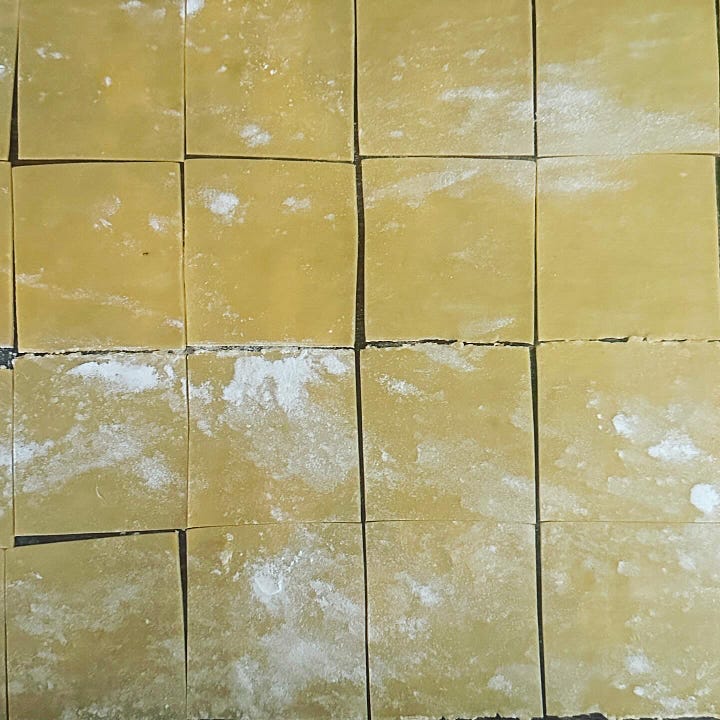
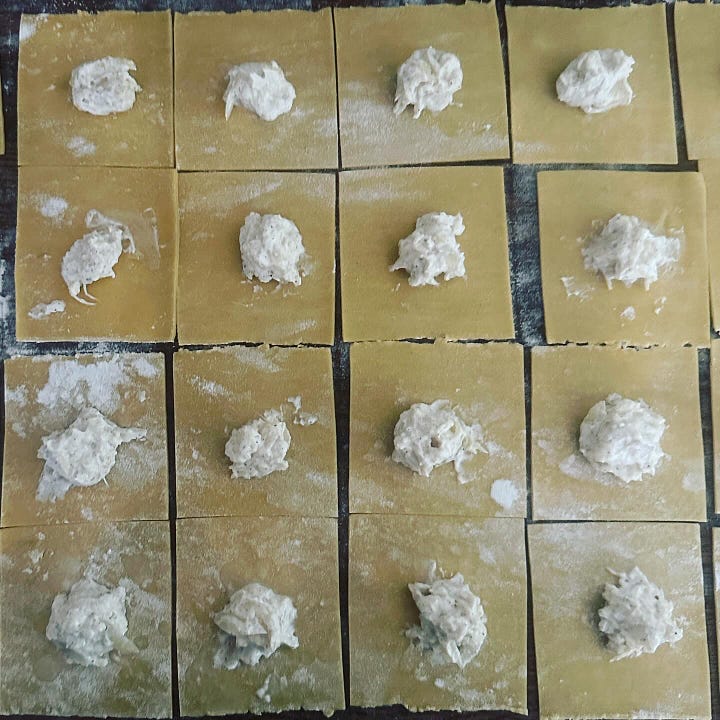
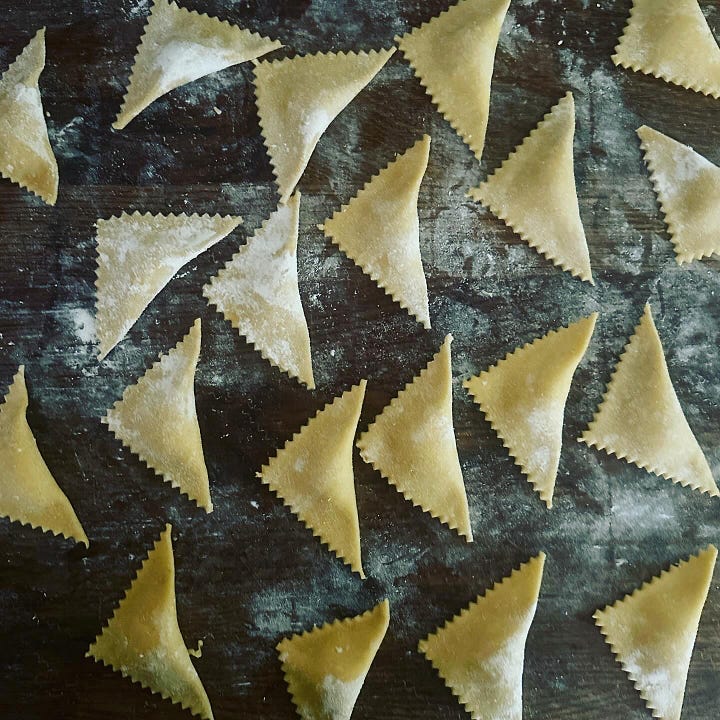
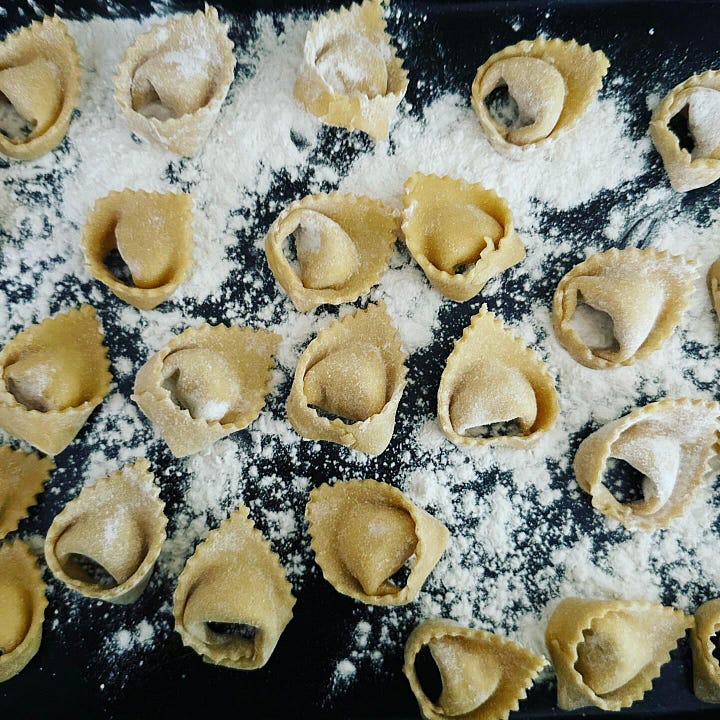
Fold the triangles so the non-right-angled corners meet and squeeze them together. I was going to film a little instructional video for this but this reel from Instagram is so much better lit than anything I could manage in my kitchen. Have a look for a good demo of folding technique.
Put the butter and sage in a large frying pan, preferably one with a white or shiny interior. Melt the butter over a medium heat then turn it up and let the butter bubble. After a minute or so the milk solids (little white specks) will begin to brown and smell toasty. If your pan doesn’t have a pale bottom, use a spoon to keep lifting up spoonfuls so you can see when this is happening. As soon as it does, take the pan off the heat and squeeze in the lemon. Remove the sage leaves and set them aside.
Boil a large pan of water and add a good pinch of salt. Cook the tortelloni for 3 minutes (from when they come back to the boil) then use a slotted spoon to transfer them into the butter pan. They should have plenty of water still clinging to them. Give everything a really vigorous shake. This will help the butter and residual water on the pasta emulsify into a creamy sauce.
Serve immediately with the crispy sage leaves and plenty of Parmesan.
Notes (If Ifs And Ands Were Pots And Pans…)
Not all ricottas are created equal. I bought some Nonno Nanni ricotta from my local Italian deli the first time I made this (shout out to All Star Food & Wine on Green Lanes!) and it was a revelation. So much denser and creamier than the supermarket stuff. But when I went back they didn’t have that brand and I got some from Castelli instead which was totally different: much moister but with beautiful milky taste. Any ricotta will work but most will benefit from draining in a sieve over a bowl for an hour or so to remove excess water (my Castelli certainly needed this and anything from a supermarket will too). It’s important to get as much moisture out of your pasta filling as possible or it will make the pasta soggy.
The onion is optional. I know it’s an extra step but some allium sweetness does play very nicely with sage so I recommend it if you can at all be bothered.
If you’re using bought preserved lemons then you’ll probably need to discard the pulp (which has a high water content and is not terribly complex in flavour) and finely chop the skin.
Egg whites freeze very well so even if you don’t fancy making meringue right now, put them in a container (labelled with how many are in there!) and save them for later.
This butter is a great non-recipe-recipe to have in your arsenal. It’s also absoltely gorgeous with any pumpkin or squash-filled pasta.
Recipe: Quick Pasta with Preserved Lemon and Ricotta
Serves 4
Ingredients
350g dried pasta of your choice
250g ricotta
1 tbsp preserved lemon paste
1/4 tsp nutmeg
50g finely grated Parmesan (or veggie hard cheese), plus more to serve
black pepper
Method
Boil the pasta according to packet instructions.
Drain, reserving a cup of cooking water.
Put the ricotta, lemon, nutmeg and Parmesan into the now-empty pasta pan and stir to combine.
Add the pasta and a splash of cooking water. Put the pan back on the heat and stir vigorously to coat the pasta in the creamy sauce. Let it bubble for just 30 seconds or so, addming more pasta water if you need, to get a nice honogenous texture. Serve immediately with more Parmesan.
Notes (If Ifs And Ands Were Pots And Pans…)
This needs something green on the side to cut through the richness. A sharply dressed salad or some wilted spinach would be my choice.
See notes above about ricotta but it’s not necessary here to drain the cheese.
Cultural Fun
I’ve been listening to the audiobook of Oliver Burkeman’s 4,000 Weeks which is striking all sorts of chords. It’s a time management book but one that breaks with the gospel of productivity.
The title is a reference to the average lifespan. Doesn’t sound much when put like that, does it? But instead of talking about how to Get More Done, he advises making better, more concious choices about what to neglect: “Missing out is what makes our choices meaningful in the first place.”
This made a lot of sense to me. Whilst I’d be lost without my to-do lists, I have become increasingly aware that I operate as if my life will truly start later. Once I’ve finished a particular project/lost weight/painted the hall/cleared the decks/replied to all my emails. And on and on. Middle age comes with the revelation that there is a finite amount of “later” so learning to live with this finitude and make decisions accordingly seems vital.
We saw Frank Skinner at the weekend, doing his Thirty Years of Dirt show that got such great reviews at Edinburgh. I enjoyed it - he’s such genial company it would have been impossible not to - but was slightly dissapointed that he didn’t dig a bit deeper into his theme.
Ostensibly the show was about why there’s been so much “filth” in his act. He’s obviously a very clever man so I would have loved to hear his real thoughts on this and on rudeness in comedy and culture in general. But - apart from a very amusing routine about “d*ck jokes” being his Cathy from Wuthering Heights, constantly tapping and asking to be let in - he largley left it unexplored.
So I guess we’re on the slippery slope to Christmas already. Wait, that sounds Scrooge-like and I don’t mean it grouchily. I love the season but I’m not a big believer in the rise and rise of increasinly extravagant advent calendars. Perhaps it’s the lingering legacy of my Yorkshire methodist grandparents but I’m uncomfortable with that level of excessive treatery. Christmas is coming. That’s the treat. The advent calendar is a countdown to it. You don’t need a chocolate every day. Especially not in the morning. Even less so a piece of cheese/miniature bottle of gin/tiny beauty product you’ll never use.
I like a very traditional advent calendar with picture of eg. a robin behind the doors. Festive but also slightly boring. A countdown.
However, my exception to the above rule is the Exit Game advent calendar. Exit Games are sort of escape rooms you can do without leaving your house. A series of puzzles best done collaboratively. They’re ingeniusly constructed and the company that makes them produce advent calendars too with a tiny little mystery to solve every day. A few minutes of puzzling each morning seems like a fun but non-indulgent way to start the day. We got one last year and I’ve just ordered the 2023 version.
Bye! See you soon!
In the meantime, if you felt like sharing In Good Taste with friends or family who might enjoy it, you can do so with the button below. It would mean the world to me. Thanks so much.
In Good Taste is a Sycamore Smyth newsletter by me, Clare Heal.
You can also find me on Instagram or visit my website to find information about my catering work, cookery lessons and upcoming events.


